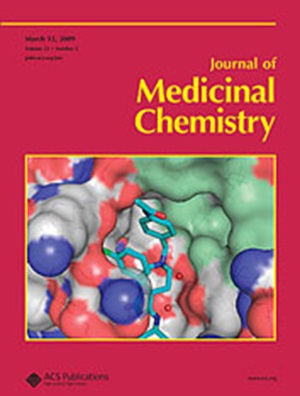Novel Small-Molecule miR-124 Inducer Acts as "a Physiological Brake" of Inflammation in Ulcerative Colitis by Targeting the PIK3R2/PI3K/Akt Axis.
IF 6.8
1区 医学
Q1 CHEMISTRY, MEDICINAL
引用次数: 0
Abstract
Ulcerative colitis (UC), a chronic inflammatory bowel disease with limited therapeutic options, necessitates novel treatments targeting its complex pathophysiology. This study identified FHND5032, a novel small-molecule miR-124 inducer, as a potent therapeutic candidate for UC. We found that FHND5032 significantly upregulated miR-124 expression in macrophages, surpassing the clinical-stage comparator ABX464 in vitro and in vivo. Mechanistically, miR-124-5p directly targeted PIK3R2, suppressing the PI3K/Akt pathway and decreasing proinflammatory cytokines while promoting M2 macrophage polarization. In dextran sodium sulfate-induced mouse colitis, FHND5032 markedly reduced the disease activity index, restored colon length, preserved mucosal architecture, and repaired intestinal barrier integrity. Additionally, FHND5032 reversed gut dysbiosis by reducing Proteobacteria and enriching beneficial Firmicutes, outperforming ABX464 in microbiome modulation. Safety assessments confirmed no organ toxicity or biochemical abnormalities. Collectively, FHND5032 exerted multifaceted anticolitis effects by targeting the PIK3R2/PI3K/Akt axis, restoring immune homeostasis, and modulating gut microbiota, positioning it as a promising therapeutic agent for UC.新型小分子miR-124诱导剂通过靶向PIK3R2/PI3K/Akt轴作为溃疡性结肠炎炎症的“生理制动器”。
溃疡性结肠炎(UC)是一种治疗选择有限的慢性炎症性肠病,需要针对其复杂的病理生理进行新的治疗。本研究确定了FHND5032,一种新型的小分子miR-124诱导剂,作为UC的有效治疗候选药物。我们发现FHND5032在巨噬细胞中显著上调miR-124的表达,在体外和体内均超过临床阶段比较物ABX464。在机制上,miR-124-5p直接靶向PIK3R2,抑制PI3K/Akt通路,降低促炎细胞因子,促进M2巨噬细胞极化。在葡聚糖硫酸钠诱导的小鼠结肠炎中,FHND5032显著降低疾病活动性指数,恢复结肠长度,保留粘膜结构,修复肠屏障完整性。此外,FHND5032通过减少变形菌群和丰富有益厚壁菌群来逆转肠道生态失调,在微生物组调节方面优于ABX464。安全性评估证实无器官毒性或生化异常。综上所述,FHND5032通过靶向PIK3R2/PI3K/Akt轴、恢复免疫稳态和调节肠道微生物群,发挥了多方面的抗结肠炎作用,使其成为一种有前景的UC治疗剂。
本文章由计算机程序翻译,如有差异,请以英文原文为准。
求助全文
约1分钟内获得全文
求助全文
来源期刊

Journal of Medicinal Chemistry
医学-医药化学
CiteScore
4.00
自引率
11.00%
发文量
804
审稿时长
1.9 months
期刊介绍:
The Journal of Medicinal Chemistry is a prestigious biweekly peer-reviewed publication that focuses on the multifaceted field of medicinal chemistry. Since its inception in 1959 as the Journal of Medicinal and Pharmaceutical Chemistry, it has evolved to become a cornerstone in the dissemination of research findings related to the design, synthesis, and development of therapeutic agents.
The Journal of Medicinal Chemistry is recognized for its significant impact in the scientific community, as evidenced by its 2022 impact factor of 7.3. This metric reflects the journal's influence and the importance of its content in shaping the future of drug discovery and development. The journal serves as a vital resource for chemists, pharmacologists, and other researchers interested in the molecular mechanisms of drug action and the optimization of therapeutic compounds.
 求助内容:
求助内容: 应助结果提醒方式:
应助结果提醒方式:


